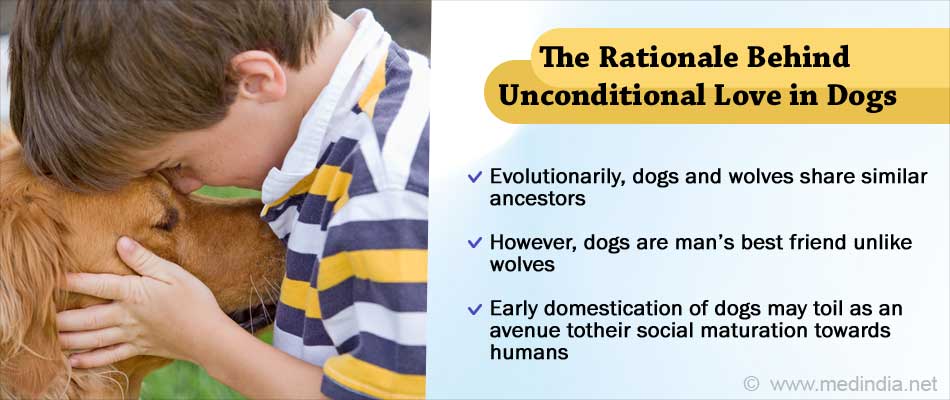as to how domestication altered the dog’s cognition.
Experts speculate that this was due to
who was once feared, and these unusual social skills of communication arose early in their development.
of 44 dogs with 37 wolf puppies of 5-18 weeks old.
It was observed that dog puppies exhibited enhanced attraction to humans (almost more than double), with the more skillful ability to read human gestures and better eye contact with humans when compared to wolf puppies.
This was even though the wolf puppies received more intense human socialization. The study depicts the role of domestication in further enhancing the cooperative-communicative abilities of dogs and favors the evolutionary hypothesis.
Why Dogs are Nurtured Equally as Kids – Supporting Ideologies
Reports also propose that domestic dogs are more thriving in communicative gestures with humans (similar to human children) when compared to even mother-reared chimpanzees and other great apes. This quality of dogs is present almost instantly to them without any intensive training.
Hence apart from relying on the olfactory cues and bodily gestures alone, the dogs and human infants bestow similar correlated variance in their use of different human gestures. This is not observed in other great apes.
The Domestication Hypothesis (DH)
The domestication hypothesis (DH) points that the innate character of the dogs to understand human gestures is a product of domestication.
The differences in varied breeds are predicted by genetic similarity among them and the genes expressed in the brain. This relates independently to other cognitive tasks. Thus 40% of the variation in this skill is found to be attributable to genetics.
The other striking feature of the dogs that make them extra friendly is their interspecific communicative abilities that emerge early. Right at the age of weaning (∼7-9 weeks) in dog puppies, they are capable enough to already use human gestures.
In an experimental setup, the foxes were analyzed for similar attraction to humans by their exposure and domestication. It was found that the experimental foxes used human gestures at a similar level to dog puppies.
This in turn supports the ideology of a similar process that had evolutionarily occurred during dog domestication and it led to the early emergence of dogs’ unusual social skills.
The Canid Ancestry Hypothesis (CAH)
The CAH in contrast to the DH, suggests that rather than gaining these interspecific communicative abilities from their ancestors, the dogs inherited the skills from the wolves. The spontaneous learning of human gestures by the adult wolves is viewed as support for this theory.
However, only limited data exist to support this fact. Thus two contrasting views support the early domestication in dogs – either from their common ancestor with wolves or lacking sensitiveness of data to support the CAH in wolf puppies.
Dogs are Our Best Buddies
Nevertheless, even the young dog puppies around the age of weaning are shown to be attracted to humans more than wolves puppies, despite limited human interaction. This greatly favors the predictions of the domestication hypothesis.
The ideology thereby suggests that the dog but not wolf puppies show increased attachment to humans with social maturity skills for reading human gestures. The dogs also had better non-social skills, that is, specialized for cooperative communication with humans.
Here, the fear component was replaced by attraction. This lays emergence from the idea that unusual interest in humans is the main drive that motivates this domestication. However future research is required to solve the further evolutionary process and look for any variation in social skills across groups of domestic dogs and wolves.
Facts on Dogs
-
Dogs have nearly 40x better sense of smell than humans, depending on the breed (300 million receptors for smell stimuli). - This sense of olfaction is utilized to sniff out even certain medical conditions.
- A specific breed of dog – Bloodhound’s sense of smell is so strong that it can follow tracks of over 300 hours old. They are commonly used as evidence in a court of law.
- Similar to a person’s fingerprint, a dog’s nose print is also unique.
- Certain breeds of dogs like Greyhound can outrun a cheetah at a top speed of 45mph within seconds and easily continue this for seven miles.
- Dogs generally sweat on their paws.
- Certain dogs have a preference for paw dominance (right or left) similar to humans.
- Apart from the smell, dogs also have a higher range of hearing at a much higher frequency (67-45000 Hz).
- The world’s oldest dog breed is Saluki that appeared in ancient Egyptian tombs in 2100 B.C.
- Even dogs dream! However, puppies and senior dogs dream more often than adult dogs.
- There are roughly 18 muscles that move the dog’s ears. This aids in their way of expressing a lot of feelings and communication.
- Yawning is contagious for all of us! Even for our dogs.
- Dogs are capable of learning over 100 words and gestures – an intelligence on a par with a two-year-old child.
- Gazing into the eyes of your best friend (dogs) releases oxytocin (the “love hormone”) for you as well for them.
References:
- Cooperative Communication with Humans Evolved to Emerge Early in Domestic Dogs
– (https://www.cell.com/current-biology/fulltext/S0960-9822(21)00880-0) - 10 amazing facts about dogs
– (https://www.pdsa.org.uk/what-we-do/blog/10-amazing-facts-about-dogs) - 30 Fun and Fascinating Dog Facts
– (https://www.akc.org/expert-advice/lifestyle/dog-facts/) - 15 Amazing Dog Facts
– (https://www.purina.co.uk/articles/dogs/behaviour/common-questions/amazing-dog-facts)
Source: Medindia



